Analysis of Business Structure and Liabilities in Company Law
VerifiedAdded on 2023/06/05
|6
|1252
|343
AI Summary
This report analyses the business structure and liabilities in Company Law, with a focus on the Friends for Accounting (FFA) case study. It discusses the liabilities of partners for outstanding debt, justifications for adopting different business structures, and relevant legislations.
Contribute Materials
Your contribution can guide someone’s learning journey. Share your
documents today.
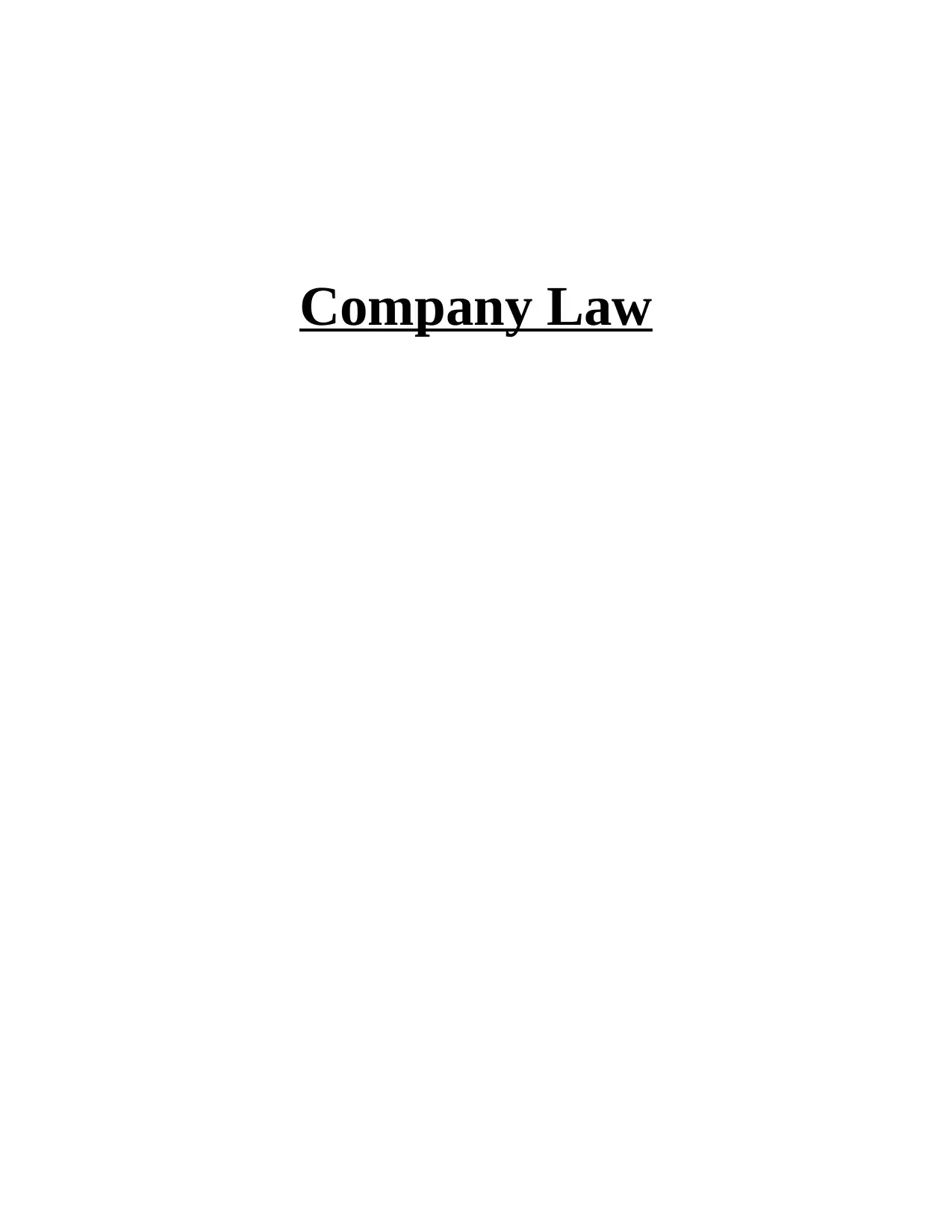
Company Law
Secure Best Marks with AI Grader
Need help grading? Try our AI Grader for instant feedback on your assignments.
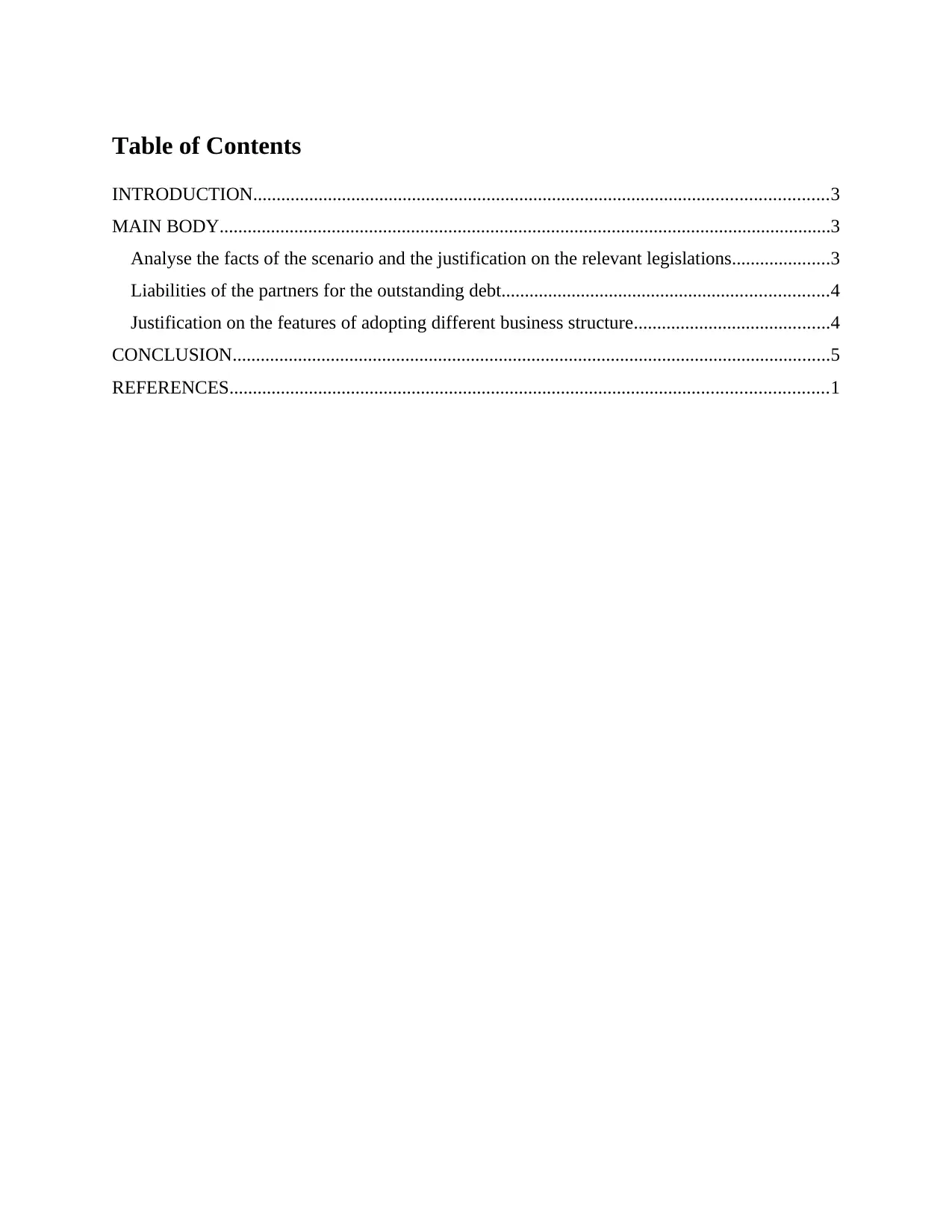
Table of Contents
INTRODUCTION...........................................................................................................................3
MAIN BODY...................................................................................................................................3
Analyse the facts of the scenario and the justification on the relevant legislations.....................3
Liabilities of the partners for the outstanding debt......................................................................4
Justification on the features of adopting different business structure..........................................4
CONCLUSION................................................................................................................................5
REFERENCES................................................................................................................................1
INTRODUCTION...........................................................................................................................3
MAIN BODY...................................................................................................................................3
Analyse the facts of the scenario and the justification on the relevant legislations.....................3
Liabilities of the partners for the outstanding debt......................................................................4
Justification on the features of adopting different business structure..........................................4
CONCLUSION................................................................................................................................5
REFERENCES................................................................................................................................1

INTRODUCTION
The body of law governing the rights, business, relations, organization, conduct of
persons and the organization is referred as the common law (Hannigan, 2018).
The report will analyse the facts of the companies and will study the adopted business
structure by the FFA. Further, it will study the financial debt of the members at time of closing of
business. Further, the report will think on the personal liability by adopting the business structure
in the organization.
MAIN BODY
Analyse the facts of the scenario and the justification on the relevant legislations
The facts have been analysed from the above scenario that the individual has started its
own accountant office after graduating from the MIT. Two friends Bindu and Alex both paid the
rent for the premises and share the space in the office. Renewing the lease includes the friends as
the partners in the organization with the equal contribution of $21,000. Friends for Accounting
(FFA) was renamed after renewal (Dine and Koutsias, 2020). The agreement of sharing of
income is distributed as the 30% share of Alex, 25% share of Bindu and the 45% share of the
individual. Bindu is only attending the office on the Friday. To discuss the management and the
accounting development FFA conduct monthly meeting. After the renowned financial chain the
first two year was performed well but afterwards there was declined in the profit of the business.
There is an outstanding debt of $100,000 for the FFA.
Due to the bank loans, rent and the utility bills the debt was incurred. FFA business has to
be closed which was decided by the partners. The business structure the FFA has adapted is the
Partnership business structure where the ownership of the business is between two or more
people in the organization. In the partnership firm there is no separate legal entity of the owners
and the business (Hannigan, 2018). In the partnership business structure the share of profit and
the loss of the business were distributed in the percentage. The FFA it was agreed to share the
profit in the ratio of 30, 25 and the 45. The case law regarding the business structure of the FFA
is The Partnership Act 1890. Partnership Act 1890 describes that the sharing of profit between
the partners in the organization is the common view of the partners in the partnership.
In the structure of the partnership business there should be minimum 2 members to form
the partnership firm. Partnership firm was set up as the general partnership. In the general
partnership there is no requirement of registration of filling of form. In the Partnership Act 1890,
The body of law governing the rights, business, relations, organization, conduct of
persons and the organization is referred as the common law (Hannigan, 2018).
The report will analyse the facts of the companies and will study the adopted business
structure by the FFA. Further, it will study the financial debt of the members at time of closing of
business. Further, the report will think on the personal liability by adopting the business structure
in the organization.
MAIN BODY
Analyse the facts of the scenario and the justification on the relevant legislations
The facts have been analysed from the above scenario that the individual has started its
own accountant office after graduating from the MIT. Two friends Bindu and Alex both paid the
rent for the premises and share the space in the office. Renewing the lease includes the friends as
the partners in the organization with the equal contribution of $21,000. Friends for Accounting
(FFA) was renamed after renewal (Dine and Koutsias, 2020). The agreement of sharing of
income is distributed as the 30% share of Alex, 25% share of Bindu and the 45% share of the
individual. Bindu is only attending the office on the Friday. To discuss the management and the
accounting development FFA conduct monthly meeting. After the renowned financial chain the
first two year was performed well but afterwards there was declined in the profit of the business.
There is an outstanding debt of $100,000 for the FFA.
Due to the bank loans, rent and the utility bills the debt was incurred. FFA business has to
be closed which was decided by the partners. The business structure the FFA has adapted is the
Partnership business structure where the ownership of the business is between two or more
people in the organization. In the partnership firm there is no separate legal entity of the owners
and the business (Hannigan, 2018). In the partnership business structure the share of profit and
the loss of the business were distributed in the percentage. The FFA it was agreed to share the
profit in the ratio of 30, 25 and the 45. The case law regarding the business structure of the FFA
is The Partnership Act 1890. Partnership Act 1890 describes that the sharing of profit between
the partners in the organization is the common view of the partners in the partnership.
In the structure of the partnership business there should be minimum 2 members to form
the partnership firm. Partnership firm was set up as the general partnership. In the general
partnership there is no requirement of registration of filling of form. In the Partnership Act 1890,
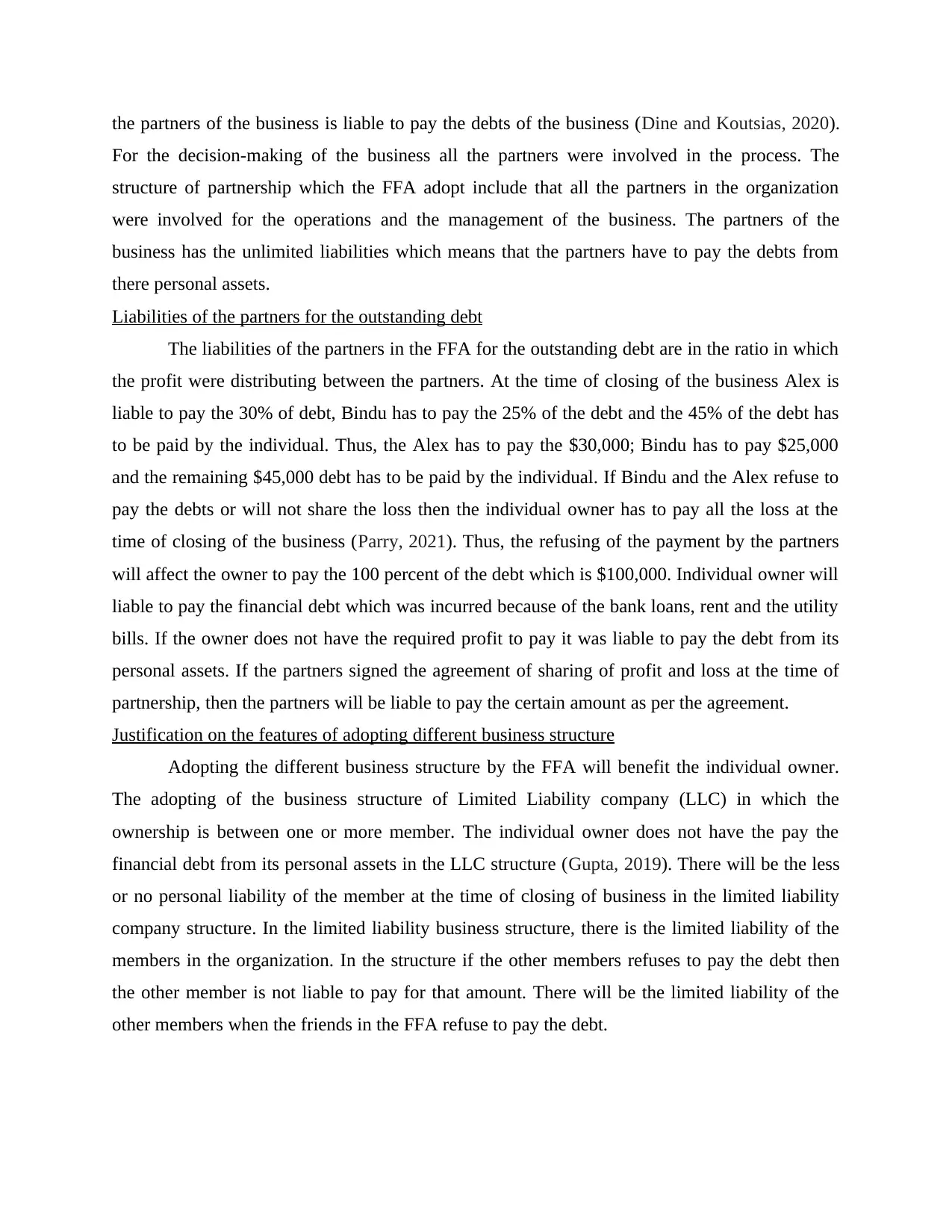
the partners of the business is liable to pay the debts of the business (Dine and Koutsias, 2020).
For the decision-making of the business all the partners were involved in the process. The
structure of partnership which the FFA adopt include that all the partners in the organization
were involved for the operations and the management of the business. The partners of the
business has the unlimited liabilities which means that the partners have to pay the debts from
there personal assets.
Liabilities of the partners for the outstanding debt
The liabilities of the partners in the FFA for the outstanding debt are in the ratio in which
the profit were distributing between the partners. At the time of closing of the business Alex is
liable to pay the 30% of debt, Bindu has to pay the 25% of the debt and the 45% of the debt has
to be paid by the individual. Thus, the Alex has to pay the $30,000; Bindu has to pay $25,000
and the remaining $45,000 debt has to be paid by the individual. If Bindu and the Alex refuse to
pay the debts or will not share the loss then the individual owner has to pay all the loss at the
time of closing of the business (Parry, 2021). Thus, the refusing of the payment by the partners
will affect the owner to pay the 100 percent of the debt which is $100,000. Individual owner will
liable to pay the financial debt which was incurred because of the bank loans, rent and the utility
bills. If the owner does not have the required profit to pay it was liable to pay the debt from its
personal assets. If the partners signed the agreement of sharing of profit and loss at the time of
partnership, then the partners will be liable to pay the certain amount as per the agreement.
Justification on the features of adopting different business structure
Adopting the different business structure by the FFA will benefit the individual owner.
The adopting of the business structure of Limited Liability company (LLC) in which the
ownership is between one or more member. The individual owner does not have the pay the
financial debt from its personal assets in the LLC structure (Gupta, 2019). There will be the less
or no personal liability of the member at the time of closing of business in the limited liability
company structure. In the limited liability business structure, there is the limited liability of the
members in the organization. In the structure if the other members refuses to pay the debt then
the other member is not liable to pay for that amount. There will be the limited liability of the
other members when the friends in the FFA refuse to pay the debt.
For the decision-making of the business all the partners were involved in the process. The
structure of partnership which the FFA adopt include that all the partners in the organization
were involved for the operations and the management of the business. The partners of the
business has the unlimited liabilities which means that the partners have to pay the debts from
there personal assets.
Liabilities of the partners for the outstanding debt
The liabilities of the partners in the FFA for the outstanding debt are in the ratio in which
the profit were distributing between the partners. At the time of closing of the business Alex is
liable to pay the 30% of debt, Bindu has to pay the 25% of the debt and the 45% of the debt has
to be paid by the individual. Thus, the Alex has to pay the $30,000; Bindu has to pay $25,000
and the remaining $45,000 debt has to be paid by the individual. If Bindu and the Alex refuse to
pay the debts or will not share the loss then the individual owner has to pay all the loss at the
time of closing of the business (Parry, 2021). Thus, the refusing of the payment by the partners
will affect the owner to pay the 100 percent of the debt which is $100,000. Individual owner will
liable to pay the financial debt which was incurred because of the bank loans, rent and the utility
bills. If the owner does not have the required profit to pay it was liable to pay the debt from its
personal assets. If the partners signed the agreement of sharing of profit and loss at the time of
partnership, then the partners will be liable to pay the certain amount as per the agreement.
Justification on the features of adopting different business structure
Adopting the different business structure by the FFA will benefit the individual owner.
The adopting of the business structure of Limited Liability company (LLC) in which the
ownership is between one or more member. The individual owner does not have the pay the
financial debt from its personal assets in the LLC structure (Gupta, 2019). There will be the less
or no personal liability of the member at the time of closing of business in the limited liability
company structure. In the limited liability business structure, there is the limited liability of the
members in the organization. In the structure if the other members refuses to pay the debt then
the other member is not liable to pay for that amount. There will be the limited liability of the
other members when the friends in the FFA refuse to pay the debt.
Secure Best Marks with AI Grader
Need help grading? Try our AI Grader for instant feedback on your assignments.
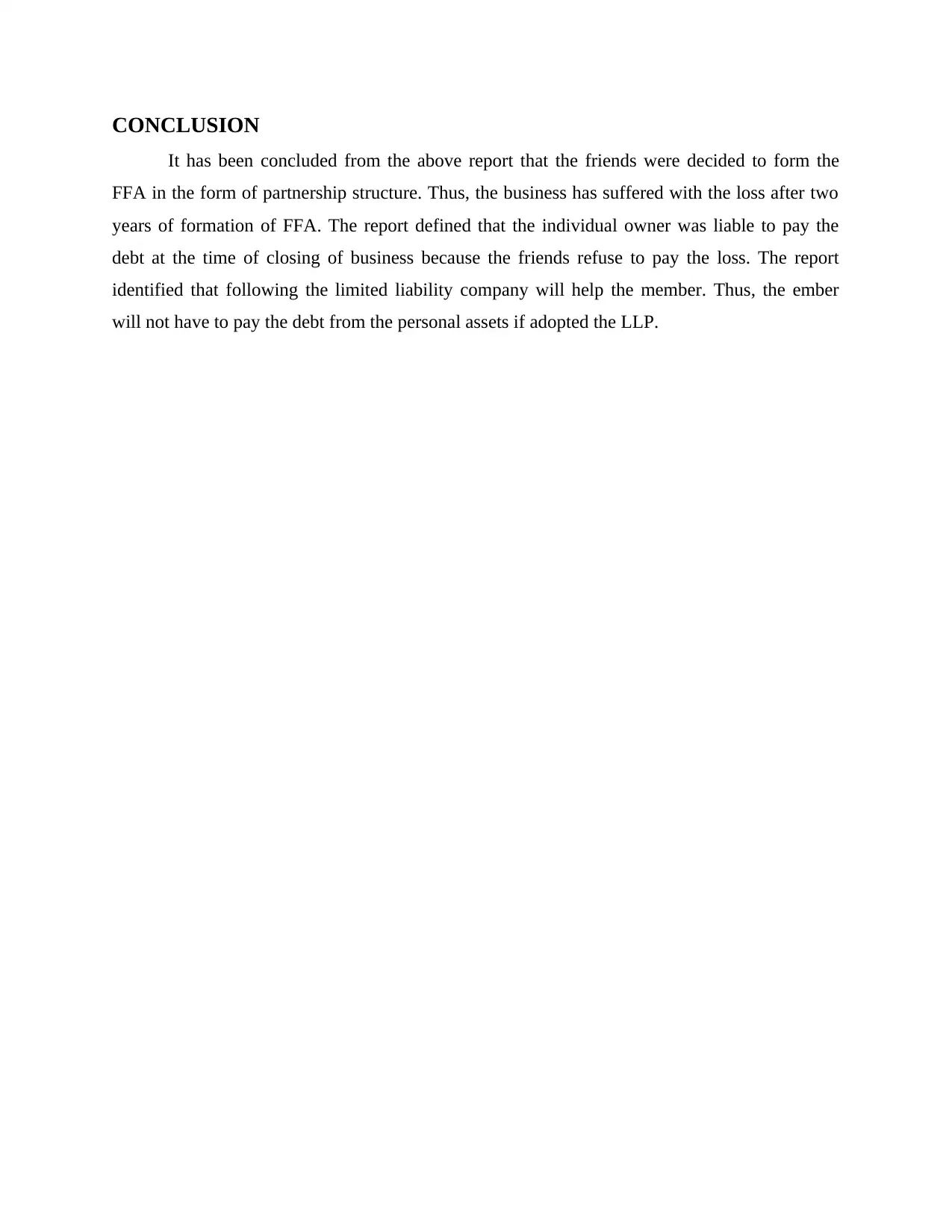
CONCLUSION
It has been concluded from the above report that the friends were decided to form the
FFA in the form of partnership structure. Thus, the business has suffered with the loss after two
years of formation of FFA. The report defined that the individual owner was liable to pay the
debt at the time of closing of business because the friends refuse to pay the loss. The report
identified that following the limited liability company will help the member. Thus, the ember
will not have to pay the debt from the personal assets if adopted the LLP.
It has been concluded from the above report that the friends were decided to form the
FFA in the form of partnership structure. Thus, the business has suffered with the loss after two
years of formation of FFA. The report defined that the individual owner was liable to pay the
debt at the time of closing of business because the friends refuse to pay the loss. The report
identified that following the limited liability company will help the member. Thus, the ember
will not have to pay the debt from the personal assets if adopted the LLP.
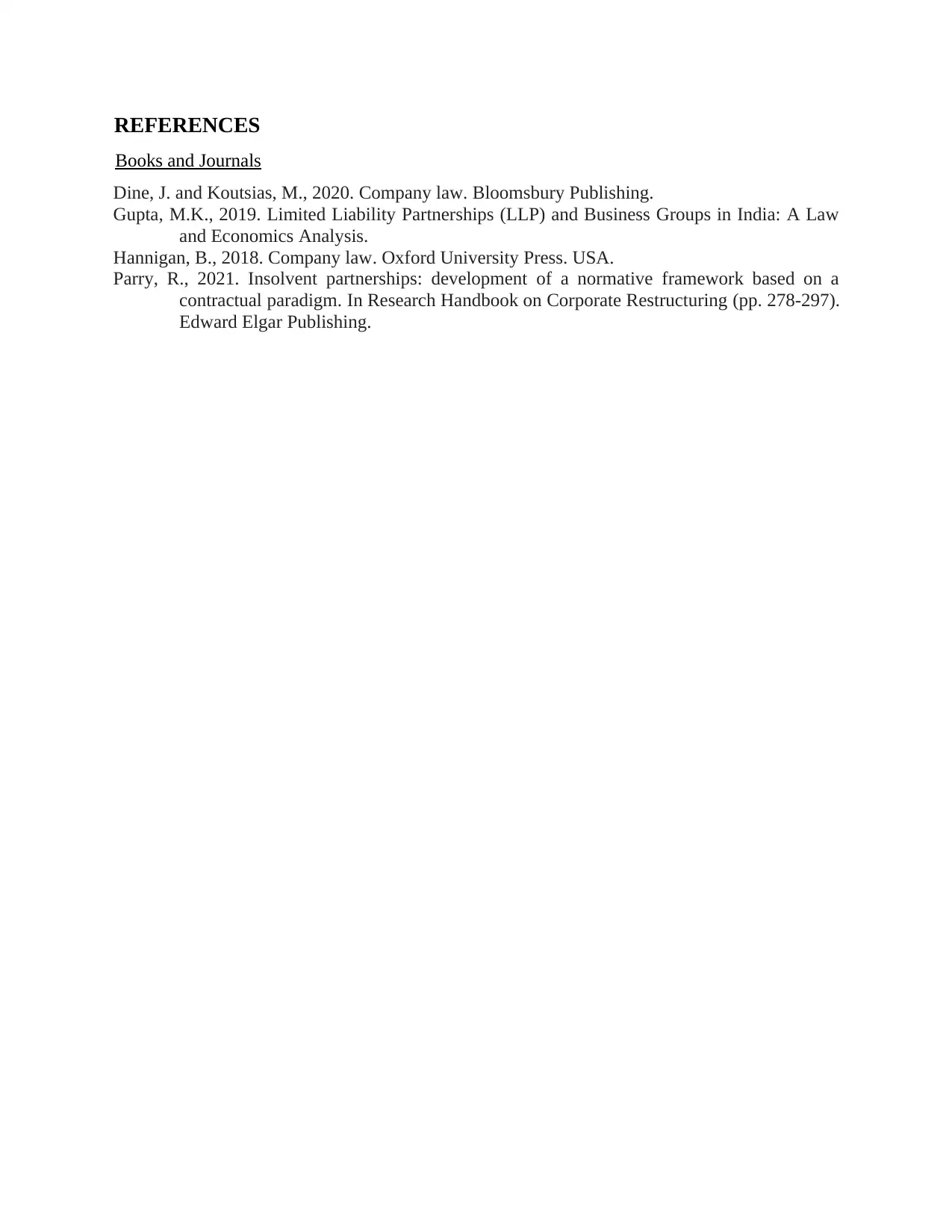
REFERENCES
Books and Journals
Dine, J. and Koutsias, M., 2020. Company law. Bloomsbury Publishing.
Gupta, M.K., 2019. Limited Liability Partnerships (LLP) and Business Groups in India: A Law
and Economics Analysis.
Hannigan, B., 2018. Company law. Oxford University Press. USA.
Parry, R., 2021. Insolvent partnerships: development of a normative framework based on a
contractual paradigm. In Research Handbook on Corporate Restructuring (pp. 278-297).
Edward Elgar Publishing.
Books and Journals
Dine, J. and Koutsias, M., 2020. Company law. Bloomsbury Publishing.
Gupta, M.K., 2019. Limited Liability Partnerships (LLP) and Business Groups in India: A Law
and Economics Analysis.
Hannigan, B., 2018. Company law. Oxford University Press. USA.
Parry, R., 2021. Insolvent partnerships: development of a normative framework based on a
contractual paradigm. In Research Handbook on Corporate Restructuring (pp. 278-297).
Edward Elgar Publishing.
1 out of 6
Your All-in-One AI-Powered Toolkit for Academic Success.
+13062052269
info@desklib.com
Available 24*7 on WhatsApp / Email
![[object Object]](/_next/static/media/star-bottom.7253800d.svg)
Unlock your academic potential
© 2024 | Zucol Services PVT LTD | All rights reserved.